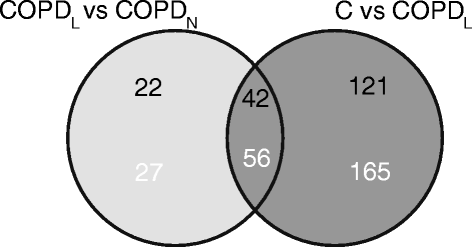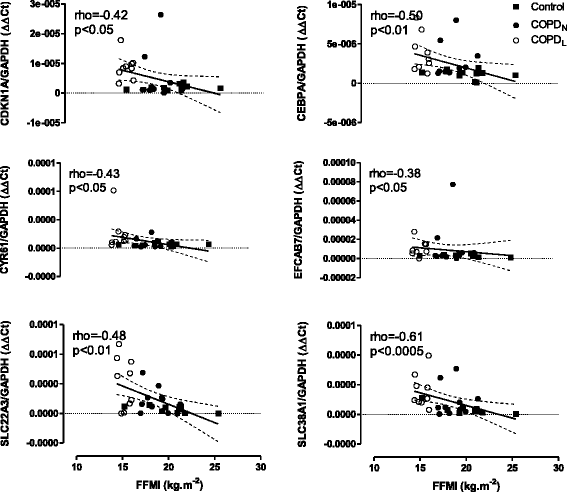Genome-wide mRNA expression profiling in vastus lateralis of COPD patients with low and normal fat free mass index and healthy controls
- PMID: 25567521
- PMCID: PMC4333166
- DOI: 10.1186/s12931-014-0139-5
Genome-wide mRNA expression profiling in vastus lateralis of COPD patients with low and normal fat free mass index and healthy controls
Abstract
Background: Chronic Obstructive Pulmonary Disease (COPD) has significant systemic effects beyond the lungs amongst which muscle wasting is a prominent contributor to exercise limitation and an independent predictor of morbidity and mortality. The molecular mechanisms leading to skeletal muscle dysfunction/wasting are not fully understood and are likely to be multi-factorial. The need to develop therapeutic strategies aimed at improving skeletal muscle dysfunction/wasting requires a better understanding of the molecular mechanisms responsible for these abnormalities. Microarrays are powerful tools that allow the investigation of the expression of thousands of genes, virtually the whole genome, simultaneously. We aim at identifying genes and molecular pathways involved in skeletal muscle wasting in COPD.
Methods: We assessed and compared the vastus lateralis transcriptome of COPD patients with low fat free mass index (FFMI) as a surrogate of muscle mass (COPDL) (FEV1 30 ± 3.6%pred, FFMI 15 ± 0.2 Kg.m(-2)) with patients with COPD and normal FFMI (COPDN) (FEV1 44 ± 5.8%pred, FFMI 19 ± 0.5 Kg.m(-2)) and a group of age and sex matched healthy controls (C) (FEV1 95 ± 3.9%pred, FFMI 20 ± 0.8 Kg.m(-2)) using Agilent Human Whole Genome 4x44K microarrays. The altered expression of several of these genes was confirmed by real time TaqMan PCR. Protein levels of P21 were assessed by immunoblotting.
Results: A subset of 42 genes was differentially expressed in COPDL in comparison to both COPDN and C (PFP < 0.05; -1.5 ≥ FC ≥ 1.5). The altered expression of several of these genes was confirmed by real time TaqMan PCR and correlated with different functional and structural muscle parameters. Five of these genes (CDKN1A, GADD45A, PMP22, BEX2, CGREF1, CYR61), were associated with cell cycle arrest and growth regulation and had been previously identified in studies relating muscle wasting and ageing. Protein levels of CDKN1A, a recognized marker of premature ageing/cell cycle arrest, were also found to be increased in COPDL.
Conclusions: This study provides evidence of differentially expressed genes in peripheral muscle in COPD patients corresponding to relevant biological processes associated with skeletal muscle wasting and provides potential targets for future therapeutic interventions to prevent loss of muscle function and mass in COPD.
Figures





References
-
- Maltais F, Decramer M, Casaburi R, Barreiro E, Burelle Y, Debigare R, Dekhuijzen PN, Franssen F, Gayan-Ramirez G, Gea J, Gosker HR, Gosselink R, Hayot M, Hussain SN, Janssens W, Polkey MI, Roca J, Saey D, Schols AM, Spruit MA, Steiner M, Taivassalo T, Troosters T, Vogiatzis I, Wagner PD. An official american thoracic society/european respiratory society statement: update on limb muscle dysfunction in chronic obstructive pulmonary disease. Am J Respir Crit Care Med. 2014;189:e15–e62. doi: 10.1164/rccm.201402-0373ST. - DOI - PMC - PubMed
-
- Engelen MPKJ, Schols AMWJ, Does JD, Wouters EFM. Skeletal muscle weakness is associated with wasting of extremity fat-free mass but not with airflow obstruction in patients with chronic obstructive pulmonary disease. Am J Clin Nutr. 2000;71:733–738. - PubMed
Publication types
MeSH terms
Substances
LinkOut - more resources
Full Text Sources
Other Literature Sources
Medical
Miscellaneous

